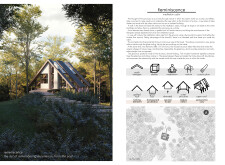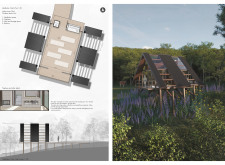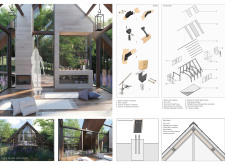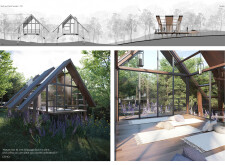5 key facts about this project
The primary function of the meditation cabin is to offer a tranquil setting for individuals seeking solitude or a break from daily life. The architecture of the cabin is equipped with elements that promote introspection, including ample natural light, open spaces, and a minimalist interior approach. This design allows users to engage in meditation or other reflective practices within a serene context.
The cabin's unique architectural attributes include a gabled roof featuring three sections, allowing for enhanced visibility of the forest landscape. This roof design is both functional and symbolic, representing a connection to the natural world. Notably, extensive use of glass walls facilitates a seamless transition between indoors and outdoors, inviting the natural environment into the architectural space. This transparency not only connects the user to nature but also maximizes passive lighting and ventilation.
Moreover, the elevated structure minimizes land disturbance, preserving the existing landscape and promoting environmental consciousness. The choice of materials, including timber and zinc, reflects a commitment to sustainability. The wood used within the interior creates a warm atmosphere, while the concrete foundation ensures stability and durability.
A notable aspect of the design is its user-centered approach—carefully considering how individuals interact with the built environment. The layout includes a spacious meditation area that encourages mindfulness practices, with specific attention to the placement of furnishings to promote a sense of calm. Outdoor terraces extend the available space, allowing users to integrate their experience with the surrounding environment.
The project distinguishes itself through its architectural integration with nature, unique roof structure, and user-focused design principles. Each element of the design reinforces the cabin's role as an ideal sanctuary for meditation, making it particularly effective for its intended purpose.
For a deeper understanding of the meditation cabin's design and its architectural ideas, we encourage readers to explore the project presentation, including architectural plans, sections, and detailed insights into the design process. Each of these elements provides further clarity on how this architecture contributes to a meaningful meditation experience.


























